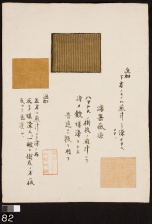Difference between revisions of "Hamanasu (Japanese rose) - top (82 T)"
Jump to navigation
Jump to search
(username removed) |
m (MDerrick moved page Hamanasu - top (82 T) to Hamanasu (Japanese rose) - top (82 T) without leaving a redirect) |
||
| (One intermediate revision by one other user not shown) | |||
| Line 5: | Line 5: | ||
| 82 | | 82 | ||
|- | |- | ||
| − | ! scope="row"| | + | ! scope="row"|Uemura number / title |
| − | | | + | | ; "Haze-some 25" |
|- | |- | ||
! scope="row"|Folder location | ! scope="row"|Folder location | ||
| Line 44: | Line 44: | ||
| - | | - | ||
|- | |- | ||
| − | ! scope="row"| | + | ! scope="row"|Uemura's notes |
| With this plant, the root is most commonly used as dyestuff. Dyeing with the bark of its trunk would generally achieve lighter colors than the bark of its root. | | With this plant, the root is most commonly used as dyestuff. Dyeing with the bark of its trunk would generally achieve lighter colors than the bark of its root. | ||
|- | |- | ||
| − | ! scope="row"| | + | ! scope="row"|Uemura's date |
| Kyoto | | Kyoto | ||
|} | |} | ||
| − | [[Category: | + | [[Category:Uemura dye archive]] |
Latest revision as of 13:55, 22 June 2020
| Museum number | 82 |
|---|---|
| Uemura number / title | ; "Haze-some 25" |
| Folder location | 1st shelf |
| Sample location | top (82 T) |
| Fiber type | silk |
| Color | dark brown |
| Dyestuff (Japanese common name) | はまなす : Hamanasu |
| Dye (English common name) | Japanese Rose/Red Rose |
| Dyestuff (botanical name) | Rosa rugosa Thunb. |
| Plant part | branch /dried (?) |
| Dyestuff extraction | boiled in water |
| Auxiliary agent in dye bath | - |
| Mordant | iron |
| Other auxiliary agent | - |
| Uemura's notes | With this plant, the root is most commonly used as dyestuff. Dyeing with the bark of its trunk would generally achieve lighter colors than the bark of its root. |
| Uemura's date | Kyoto |
